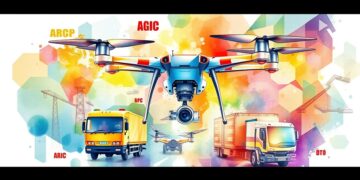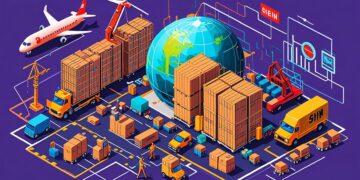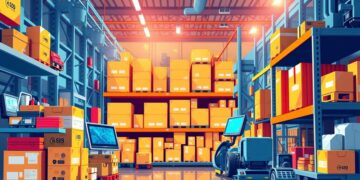The Role of the Internet of Things (IoT) in Optimizing Shein’s Logistics

Shaping the Future with IoT in Logistics
The logistics industry is currently experiencing a remarkable change, fueled by advancements in technology. Among these innovations, the Internet of Things (IoT) stands out as a pivotal force, fundamentally altering how companies manage their supply chains and delivery systems. For influential brands like Shein, IoT transforms logistics from a mere necessity into a strategic advantage, fostering enhanced efficiency and optimizing core operational processes.
Real-Time Inventory Tracking
One of the most noteworthy benefits of incorporating IoT technology is the ability to track inventory in real-time. By equipping products with smart sensors, companies can monitor stock levels, locations, and conditions continuously. This capability minimizes the risk of overstocking or stockouts, allowing businesses to maintain the right balance of inventory. For instance, a retailer using IoT can receive alerts when stock levels dip below a certain threshold, enabling timely replenishment.
Streamlining Supply Chain Operations
Moreover, IoT facilitates the streamlining of supply chain operations. With interconnected devices, businesses can analyze data from various stages of the supply chain—from manufacturing to transportation. This integration helps identify bottlenecks and inefficiencies that can be addressed promptly. For example, logistics firms can track shipping containers equipped with IoT devices, gaining insights into transit times and conditions. As a result, organizations can make informed decisions that enhance delivery times and reduce delays.
Cost Reduction Strategies
As costs continue to rise across industries, leveraging IoT can lead to a significant reduction in operational costs. By automating processes and improving logistics visibility, companies can minimize waste and reduce manual labor requirements. A case in point is warehouse automation, where IoT-enabled robots and smart shelves optimize storage and picking processes. This not only cuts labor costs but also boosts accuracy in order fulfillment, further increasing customer satisfaction.
The Competitive Edge for Shein
As Shein navigates the highly competitive fashion market, the incorporation of IoT in logistics is crucial. This strategy not only bolsters customer satisfaction through timely deliveries but also enhances the company’s agility in responding to evolving market demands. Understanding the intricate relationship between IoT and logistics provides businesses with the tools to adapt swiftly and efficiently to changes in consumer preferences and trends.
In conclusion, the integration of IoT technology in the logistics sector presents a myriad of opportunities for companies to optimize operations. The ongoing evolution of this technology promises to unlock new pathways to success, allowing businesses to maintain a competitive edge in an increasingly digital marketplace. By exploring the potential of IoT, organizations like Shein can further solidify their position as leaders in their respective industries.
DISCOVER MORE: Click here to learn about influencer collaborations
Enhancing Visibility and Efficiency through IoT
In the fast-paced world of e-commerce, where consumer expectations are ever-increasing, brands like Shein are embracing the Internet of Things (IoT) to enhance logistics capabilities significantly. By harnessing the power of IoT, Shein can create a highly responsive logistics framework that not only improves operational efficiencies but also fosters stronger relationships with customers. One of the most significant aspects of IoT integration in logistics is its contribution to visibility and efficiency across the supply chain.
The Power of Data-Driven Decisions
IoT enables the collection and analysis of vast amounts of data from various touchpoints in the logistics chain. This wealth of information allows Shein to refine its logistics strategies based on real-time insights, leading to better forecasting and demand planning. Key metrics such as:
- Delivery times
- Transportation costs
- Customer satisfaction levels
- Inventory turnover rates
can be monitored and analyzed, empowering Shein to make data-driven decisions that enhance delivery performance and consumer experiences. By leveraging these insights, Shein can proactively address operational challenges, enabling the company to stay ahead of potential disruptions or inefficiencies that may arise.
Smart Transportation Management
Another crucial area where IoT significantly impacts Shein’s logistics is in transportation management. The integration of IoT devices into shipping and logistics vehicles allows for real-time tracking of deliveries and monitoring of vehicle conditions. Through GPS sensors and telemetry systems, Shein gains visibility into:
- Vehicle locations and routes
- Traffic conditions
- Estimated time of arrival (ETA)
This level of insight creates opportunities for more efficient route planning and timely interventions in the event of delays. For example, if a shipment is experiencing unforeseen delays, Shein can quickly reroute the vehicle or notify customers, enhancing transparency and trust. Such proactive measures not only optimize logistics operations but also align with consumers’ demands for timely and reliable deliveries.
Elevating the Customer Experience
Ultimately, the integration of IoT in logistics cultivates an enhanced customer experience, a critical factor in Shein’s success in the saturated online fashion market. Providing customers with real-time updates about their orders—from the moment they place their order to the moment it arrives at their doorstep—creates an appealing shopping experience that helps build brand loyalty. Furthermore, by ensuring that products are available when needed and delivered promptly, Shein reinforces its reputation as a customer-centric brand.
In a digital age where convenience is paramount, the role of IoT in optimizing logistics cannot be overstated. As Shein continues to innovate within its logistics framework, the potential for expanding market reach and solidifying its position as an industry leader grows exponentially.
| Advantage | Description |
|---|---|
| Real-Time Inventory Management | Efficient tracking of inventory levels using IoT devices enables Shein to reduce overstock and stockouts, ensuring optimal product availability. |
| Enhanced Supply Chain Visibility | IoT sensors provide comprehensive visibility into the supply chain, allowing Shein to make informed decisions swiftly and adapt to changes in demand. |
In exploring the critical role of the Internet of Things (IoT) in streamlining Shein’s logistics, it’s important to focus on how these technological advancements translate into tangible benefits. With the implementation of IoT, Shein leverages real-time data to create a more responsive and efficient logistics model. For instance, using IoT-enabled devices allows for real-time inventory management, which not only minimizes unnecessary holding costs but also enhances customer satisfaction by ensuring that items are readily available.Furthermore, the use of IoT sensors within Shein’s supply chain facilitates enhanced visibility into operations. This means that every shipment, from the moment it leaves the factory to its arrival at the distribution center, can be tracked effortlessly. Such capabilities not only help to optimize routes but also allow Shein to promptly address any disruptions, ensuring that the flow of goods remains uninterrupted. This level of connectivity paves the way for increased operational efficiency and ultimately supports Shein’s mission to deliver quality fashion at lightning speed.
DISCOVER MORE: Click here to learn about the future of logistics</
Transforming Inventory Management
In addition to enhancing visibility and efficiency, the Internet of Things (IoT) plays a pivotal role in transforming inventory management for Shein. As fashion retail is susceptible to rapid changes in trends and customer preferences, managing inventory levels accurately is crucial for maintaining a competitive edge. Through IoT-enabled devices such as smart shelves and RFID tags, Shein can gain real-time insights into stock levels across its distribution centers and retail locations.
Real-Time Inventory Tracking
By implementing IoT technology, Shein can automate the inventory tracking process, reducing human error and improving accuracy. This system allows Shein to monitor product availability in real time, which leads to:
- Minimized stockouts and overstocks
- Improved order fulfillment rates
- Enhanced demand forecasting
The ability to track inventory in real-time not only streamlines operations but also alleviates the uncertainty associated with product demand. For instance, if a particular clothing item is experiencing a surge in orders, Shein can quickly identify the need to replenish stock. Likewise, items with lower turnover rates can be discounted or bundled to encourage sales, optimizing inventory management strategies effectively.
Streamlined Warehouse Operations
Warehouse operations represent another area where IoT can significantly contribute to the efficiency of Shein’s logistics. By utilizing IoT devices such as autonomous guided vehicles (AGVs) and smart pallets, Shein can automate various warehouse tasks, including picking, packing, and sorting. These advancements not only reduce operational costs but also enhance the overall speed of order processing.
The integration of IoT in warehouses enables Shein to:
- Increase processing speed by automatically directing workers and robots to required locations
- Reduce human labor while retaining high accuracy in order fulfillment
- Gather data on warehouse performance metrics to facilitate ongoing improvement
Such automation can lead to significant reductions in labor costs and improved turnaround times, which is particularly important for Shein’s model of rapid fashion delivery. For a brand for which timely delivery can be a defining feature, the impact of streamlined warehouse operations cannot be overstated.
Environmental Impact and Sustainability
Furthermore, IoT has the potential to support Shein’s sustainability initiatives as part of its logistics optimization. The ability to gather data on energy consumption, transportation emissions, and waste management empowers Shein to make environmentally conscious decisions. For instance, by analyzing transportation routes and vehicle performance, Shein can identify opportunities to reduce fuel consumption and lower emissions.
As consumers increasingly gravitate towards brands that demonstrate environmental responsibility, showcasing a commitment to sustainability can be a powerful differentiator in a competitive market. Hence, utilizing IoT for logistics not only fuels operational efficiency but also aligns with the growing consumer demand for ethical and responsible shopping.
In the end, the integration of IoT into Shein’s logistics operation is a multifaceted approach that addresses challenges in inventory management, optimizes warehouse processes, and embraces sustainability efforts. As Shein continues its journey through the complexities of global logistics, the potential for innovation driven by IoT remains immense and multifaceted, promising to rewrite the rules of fashion retail logistics.
DIVE DEEPER: Click here for more insights
Conclusion
In conclusion, the Internet of Things (IoT) is undeniably redefining logistics within Shein, providing a roadmap for future innovations tailored to meet the dynamic demands of the fashion retail industry. By integrating IoT technologies such as real-time inventory tracking, automated warehouse operations, and sustainability-focused data analytics, Shein significantly enhances its operational efficiency. This not only leads to reduced operational costs and timely order fulfillment but also strategically positions the brand as a leader in an increasingly competitive environment.
Moreover, the emphasis on sustainability through smart logistics practices reflects a broader consumer trend favoring brands that prioritize ecological responsibility. As an illustration, the ability to monitor transportation emissions enables Shein to adapt and optimize its logistics in alignment with growing environmental consciousness among consumers. By merging technology with sustainability, Shein is not just crafting a competitive edge but also fulfilling the evolving expectations of today’s market.
As the fashion landscape continues to change at a rapid pace, the role of IoT in logistics will only increase. With each advancement in IoT, Shein can continue to anticipate consumer needs more effectively, navigate complexities in supply chain management, and promote practices that resonate well with values of sustainability. Therefore, it would be prudent for industry players to observe Shein’s journey and the transformative potential of IoT, heralding a new era in fashion retail logistics that champions efficiency and environmental stewardship.

Linda Carter is a digital business trends writer and strategist specializing in emerging technologies and online revenue models. With extensive experience helping entrepreneurs and professionals adapt to the digital economy, she shares actionable insights on our platform about monetization strategies, consumer behavior shifts, and next-wave innovations. Her goal is to empower readers with practical frameworks to future-proof their businesses and capitalize on digital opportunities.






